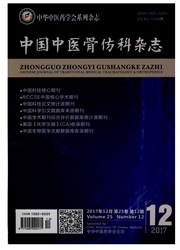

 中文摘要:
中文摘要:
目的:检测腺苷酸活化蛋白激酶(AMP-activated protein kinase,AMPK)及其相关分子在正常与退变腰椎间盘髓核中的表达情况,并探讨AMPK在椎间盘退变中的作用。方法:取6例正常和10例腰椎间盘突出症患者的髓核组织,Western Blot检测线粒体能量代谢相关蛋白质AMPK的含量和磷酸化状态,免疫组化检测细胞衰老相关基因p16INK4a和细胞增殖相关基因mTOR的表达。结果:退变髓核组织中AMPK和磷酸化AMPK蛋白表达量较正常对照组均有所增加,二者比较差异均有统计学意义(P〈0.01)。免疫组化显示,正常对照组和退变髓核组织p16INK4a染色阳性细胞率分别为12.1%和53.1%,两者比较差异有统计学意义(P〈0.01)。正常对照组髓核组织和退变髓核组织中,mTOR染色阳性细胞率分别为55%和22.7%,两者比较差异有统计学意义(P〈0.01)。结论:能量代谢障碍是椎间盘退变的重要机制,椎间盘细胞可能通过AMPK含量和磷酸化状态的改变而调控细胞的增殖和衰老。
 英文摘要:
英文摘要:
Objective:To demonstrate the roles of AMP activated protein kinase (AMPK) in the progression of degenerative disc disease (DDD). Methods:Nucleus pulposus were collected from 6 cases of normal people and 10 cases of DDD. Western blot was performed to measure AMPK content and phosphorylation level. Immunohistochemistry was applied to detect the expressions of P16ink4a and mTOR. Results: The expression of AMPK and phaspherize AMPK in degenerative nucleus pulposus was increased significantly compare with those in normal tissue (P 〈 0. 01). Immunohistochemistry results showed that the possitive rate of p16INK4a expression in normal and degenerative nucleus pulposus was 12. 1% and 53. 1 (P〈0.01). And the possitive rate of mTOR expression in normal and degenerative nucleus pulposus was 55% and 22.7% (P〈0.01). Conclusion: Disturbance of energy metabolism is involved in the progression of degeneration of intervertebral disc. AMPK might play a important role in regulation the proliferation and insenecence of intervertebral disc cell, via regu lating the expression and phosphorization status.
 同期刊论文项目
同期刊论文项目
 同项目期刊论文
同项目期刊论文
 Development and evaluation of controllable axial loading-induced rabbit lumbar disc degeneration mod
Development and evaluation of controllable axial loading-induced rabbit lumbar disc degeneration mod Protective effects of Tanshinone ⅡA against interleukin-1 beta induced obstruction of energy metabol
Protective effects of Tanshinone ⅡA against interleukin-1 beta induced obstruction of energy metabol Adenovirus-mediated tissue inhibitor of metalloproteinase-3 gene transfection inhibits rabbit interv
Adenovirus-mediated tissue inhibitor of metalloproteinase-3 gene transfection inhibits rabbit interv 期刊信息
期刊信息
